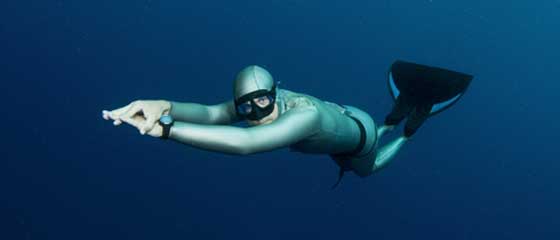
AIDA 2 Star Egypt
As taught in Dahab, Egypt.
The AIDA 2 Star course is a certified beginners freediving course typically taught over two and half days.
Although the course is suitable for individuals with little or no free diving experience, students should be competent swimmers, comfortable in and under the water.
Scuba diving experience is also advantageous as is the ability to equalise at depth.
The course offers a good mix of theory, pool sessions and open water sessions with an exam at the end.
Students will also be required to meet certain criteria of time, depth and distance on their dives in order to obtain the certification.
The course structure will likely reflect the below:
Day 1 – Theory and Pool Session
The course starts with an introduction to freediving and its various disciplines.
Students are quickly introduced to the fundamentals techniques of ‘breathing up’, taking the ‘final breath’ and ‘recovery breathing’.
If these are new techniques to you they will instantly improve your breath holding ability.
In the afternoon the pool work begins as students are trained in static (a stationary breath hold) and dynamic apnea (breath holding while swimming horizontally usually in a pool).
Students are taught swimming techniques as well as basic rescue and safety procedures for the open water.
This pool session allows students to practice the techniques demonstrated earlier that morning, gives the instructor the opportunity to assess the students, and prepares one and all for the open water sessions later in the course.
To pass this section of the course students are required to perform a 2 minutes static breath hold and complete a 40m horizontal free dive; easy once you know how.
From the offset it’s apparent that like any sport freediving is primarily about the mastery of techniques and champion bathtub breath holders do not necessarily excel.
Day 2 – Theory and Open Water
Today’s session sees students back in the classroom to prepare for the open water sessions later in the day.
Students are introduced to open water swimming and diving techniques.
The duck dive (initial entry into the water) is key to the success of any dive and practising it will likely take up much of the afternoon.
Students also taught the biology behind freediving, why we feel the ‘urge to breath’ and how to resist it. In additional students are taught about freediving equipment and how it differs from scuba equipment.
After a small lunch students have time to digest before donning a wet suit and hitting the open water.
Students first practise ‘free immersion’ (pulling oneself along a cord) before progression to ‘constant weight, the discipline most readily associated with the sport.
It’s here that students will need to duck dive into the water and then use their own body strength to descend head first along a line.
In order to be successful and extend ones breath hold, energy use must be minimised.
This is achieved through techniques shown on the course.
The day is spent mastering these techniques before the real attempts at depth begin tomorrow.
Day 3 – Exam and Final Open Water Session
After a quick classroom recap students are required to take a theoretical test based on the classroom learning’s of the course.
This is a fairly straight forward test for anyone that has been paying attention during the preceding days.
With the exam complete students head for the open water one last time, practice their duck dives and finning before attempting their dives of depth.
Progression is gradual (usually metre by metre) to ensure that students are not pushing themselves beyond their capabilities.
All dives are accompanied by a safety diver who meets the student a few metres below the surface and monitors their dive. This too is a technique students will learn on the course.
In order to pass the course students are required to perform a ‘constant weight’ dive to a depth of 20 metres.




